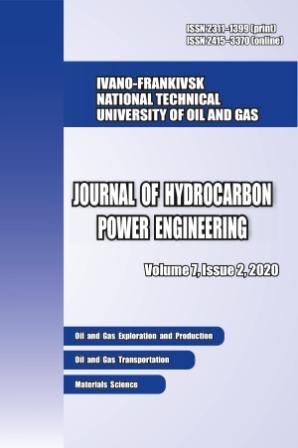Дослідження впливу технологічних параметрів імпульсного процесу на формування металу зварного шва та мікроструктуру зони термічного впливу
DOI:
https://doi.org/10.31471/2311-1399-2020-2(14)-61-70Ключові слова:
магістральні трубопроводи, імпульсно-дугове зварювання, технологічні параметри, зварне з’єднання, геометричні параметри, структураАнотація
При тривалій експлуатації металевих конструкцій збільшується вірогідність їх механічного руйнування. Це значною мірою стосується і зварних з'єднань магістральних трубопроводів. Одним з перспективних шляхів розв’язання питання підвищення терміну їх експлуатації є розробка методів зварювання, заснованих на використанні імпульсного керування енергетичними параметрами процесу. Імпульсний режим зварювання дозволяє здійснювати регульоване тепловкладення в зону зварного з'єднання, керувати режимом плавлення електродного металу і формуванням структури металу шва і зони термічного впливу (ЗТВ) .
В роботі застосовувалося два види переносу металу з електроду в зварювальну ванну: з короткими замиканнями та без них, тобто виконувалось зварювання на "довгій" дузі. При постійній швидкості подачі електродного дроту режим зварювання змінювали шляхом зміни форми вольт-амперної характеристики джерела живлення. Встановлено, що зі збільшенням частоти імпульсно-дугове зварювання за ефектом впливу на метал ЗТВ наближається до процесу зварювання стаціонарною дугою. Результати металографічних досліджень показали незначне зменшення загальної ширини ЗТВ з підвищенням частоти до 50 Гц. Подібна тенденція спостерігається і для ділянки крупного зерна в ЗТВ. Проте у порівнянні із стаціонарним процесом зварювання, ширина цієї ділянки зменшується більш суттєво – на 25…30%. Таким чином, у разі зварювання трубних сталей за рахунок застосування технології з імпульсним процесом є перспектива впливати на структуру ділянки перегріву ЗТВ при різних значеннях частот і, відносно, малих значеннях погонної енергії (6,0…6,2 кДж/см). З практичної точки зору це дозволяє зменшити в ЗТВ частку несприятливої, малопластичної ділянки перегріву, що важливо для випадків ремонту стоншень стінок труб під час заплавлення дефектів на діючому трубопроводі механізованим способом.
Завантаження
Посилання
Saraev, YuN 2001, ‘Ways to Improve the Efficiency of Construction, Operation and Repair of Oil and Gas Field Equipment and Main Pipelines Based on Adaptive Pulse Welding and Surfacing Technologies’, Welding production, vol. 5, pp. 31–37.
Mazel, AG, Tarlinsky, VD, Sheikin, MZ et al. 1979, Modern Methods of Welding Main Pipelines by Fusion, Nedra, Moscow. [in Russian]
Saraev, Yu,. Bezborodov, VP & Nikonova, IV 2009, ‘Structure and Properties of Welded Joints Zones Obtained by Adaptive Pulse-Arc Welding Methods’, Resource and diagnostics of materials and structures: proceeding Russian Sci. Tech. Conf., Yekaterinburg, May 26–28. [in Russian]
Saraev, YuN 1999, ‘Increase in efficiency of arc welding based on an adaptive algorithm for pulsed control of process energy parameters’, Welding Conference LUI Join'99 Int. Conf. on Efficient Welding in Industrial Applications (ICEWIA), pp. 222–226.
Krampit, NYu & Krampit, AG 2014, ‘Investigation of the Process of Pulsed-Arc Welding with a Consumable Electrode in Carbon Dioxide’, Bulletin of the Bauman MSTU, Ser. ‘Mech. Engineering’, vol. 5, pp. 106–112.
Knyazkov, AF & Knyazkov, SA 2011, ‘Active Control of Melting and Transfer of Electrode Metal’, Welding and diagnostics, vol. 4, pp. 27–32.
Yakushin, BF & Bakulo, AV 2017, ‘On the Mechanism of Weld Metal Structure Formation in Pulse-Arc Welding’, Welding production, vol. 9, pp. 29–35.
Verevkin, AV 2010, ‘Increasing the Efficiency of Co2 Welding of Pipelines Fixed Joints Due To the Application of Pulsed Power Supply of the Welding Arc’, Dissertation abstract for the PhD Degree, Barnaul, p. 20.
Krampit, MA, Burakova, EM & Zubenko, LN 2014, ‘Trends in the Development of Pulsed Methods for the Welding Process Control’, Innovative technologies and economics in mechanical engineering: proceedings of the V Int. Sci. & Pr. Conf., May 22–23.
Knyazkov, AF & Knyazkov, SA 2011, ‘Active Control of Melting and Transfer of Electrode Metal’, Welding and diagnostics, vol. 4, pp. 27–32.
Krampit, AG & Krampit, NYu 2015, ‘Methods for Controlling the Formation of a Weld’, Technologies and materials, vol. 2, pp. 21–26.
Golikov, NI, Sidorov, MM, Maksimova, EM & Saraev, YuN 2018, ‘Investigation of Welded Joints Microstructure Made Under Negative Temperatures’, Science – education – production: Experience and development prospects: Bulletin of the XIV Int. Sci. Tech. Conf., February 8–9, pp. 161–164.
Saraev, YN & Bezborodov, VP 2013, ‘Effect of the Energy Parameters of the Welding Process on the Structure and Properties of Welded Joints in Low-Alloy Steels’, Welding International, vol. 27, no. 9, pp. 678–680.
##submission.downloads##
Опубліковано
Як цитувати
Номер
Розділ
Ліцензія
Авторське право


.png)





.png)
